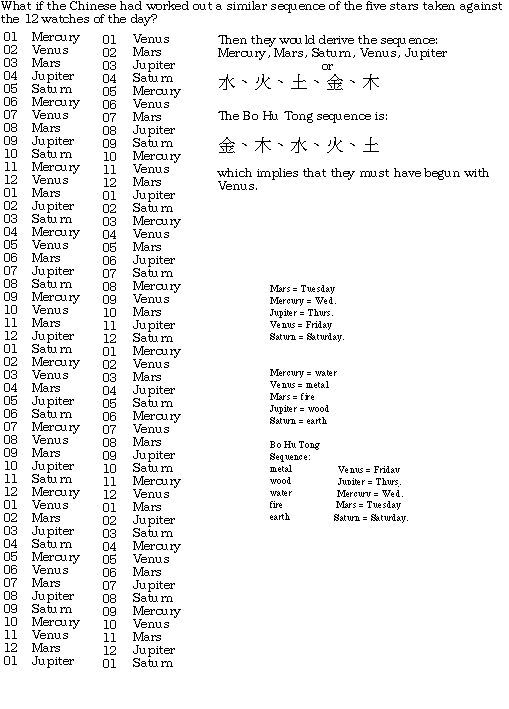
The ancient Egyptians had a ten-day week, and so did the Chinese. The ancient Assyrians invented the seven-day week, and the names of days of the week that we use even today are based on a system of assigning the five planets visible to the naked eye, the sun, and the moon to the seven days of the week.
We do not know a great deal about the transmission of cultural elements before the invention of writing, and details about such transmissions are likely to be more incomplete the farther back we go in written history. Whether there was a connection between the Chinese ten-day week and the Egyptian ten-day week is likely to have been permanently lost in the dust of history.
Even though there may be no direct records, a further similarity between Western and Chinese cultural features makes it seem very unlikely that it is all a matter of coincidence.
"The names for the days of the week which have been adopted throughout western Europe are based on the names of the seven known 'planets', arranged in their supposed order of decreasing distance from the Earth -- Saturn, Jupiter, Mars, the Sun, Venus, Mercury, the Moon -- and are of astrological origin. There was a great development of astrology in Egypt at the beginning of the Christian era; according to the current astrological beliefs, each hour in succession was consecrated to a different planet, the sequence following the order of their distance. The planet to which the first hour of the day was consecrated was regarded as the regent of that day.... In the Teutonic languages, the names of their divinities Tiu, Woden, Thor, and Freya are used instead of their Roman counterparts, Mars, Mercury, Jupiter, Venus." {{A History of Technology, volume 3, p. 565f}}

Elaborate correspondences are drawn in Chinese philosophy between sets of five. There are the five notes of the musical scale, the five "xing2", the five planets, the five colors, the five tastes (i.e., the tastes that are distinguishable by the tongue, not the tastes that require olfactory nerve participation, sweet, sour, salty, etc.), and so forth.
The names of the five planets are the same as the names of the five metaphysical "elements" mentioned above: metal, wood, water, fire, and soil. If we make the hypothesis that the Bo Hu Tong order of the five metaphysical elements follows the order of the five planets, then something very interesting emerges when we apply those five planets (which are also regarded as gods) to the twelve watches of the Chinese day.
In the following chart, I arbitrarily began the sequence of planets with Mercury because it is nearest to the Sun. The "regents" of the days, according to a scheme based on what we know of the Egyptian practice, would then be: water, fire, soil, metal, and wood. When we compare this with the Bo Hu Tong sequence we find that according to the Chinese ideas we should have started with metal or the planet Venus.

The Chinese had a system of three xun2 (ten-day weeks) per month, which could be further divided into six minor periods -- each of five days. Their names for the days of the week would then have been; Venus, Jupiter, Mercury, Mars, and Saturn. To give them Teutonic names, they would be Friday, Thursday, Wednesday, Tuesday, and Saturday ... and then back to Friday. So their sequence is the reverse of the Western sequence.
The Assyrian invention of the seven-day week required the naming of two additional days, one named after the Sun and the other named after the Moon. The seven-day week appears not to have overcome cultural inertia in China until very much later, when days of the seven-day week were given out anew, being simply "Heaven day" (or "Sun day"), weekday 1, weekday 2, ... weekday 6." So there is no simple correspondence between the two systems. When the seven day week was introduced to Japan, they named the days of the week after the sun, the moon, Mars, Mercury, Jupiter, Venus, and Saturn in the Western order.
The correspondences are there -- all except for an instance of the planet names being applied as names for the Chinese 5-day semi-xun2 week, which I have not found yet.
The five planets give over their "regency" in a regular sequence, one to the other. That seems similar to the way that the five so-called metaphysical "elements" phase into each other. It may well be that the five phases (as I shall now start calling them) are best understood as earthly manifestations of the powers of the five planets.
In Zhou Dun-yi's Tai-ji Diagram, immediately beneath the part of the chart that represents Yin and Yang, lie the two circles that enclose the characters for Fire and Water. Fire is under Yang and Water is under Yin. Wood and Metal are found found at the bottom corners of the square, with Earth in the middle.

The Chinese system is similar to the Western system in one other regard: The cosmic Yin and the cosmic Yang, i.e., the words "Yin" and "Yang", are used to name the sun and the moon. The sun is regularly called "Tai4 Yang2" (i.e., Great Yang), and the moon may be called "Tai4 Yin1" (i.e., Great Yin). So, in the metaphysical diagrams central to much of Song dynasty Neo-Confucianism, Yin, Yang, and the five "phases" are arranged schematically to indicate something about their interrelationships. And we could see the relations among the sun, moon, and five planets as emblematic or as visible indications of the cosmic forces.
It is interesting, but probably not conclusive, that the notes of the pentatonic scale are matched with the five colors, the five planets, and all the other sets of five, and that when the pentatonic scale was expanded the enlarged scale had seven notes just as the larger Western week has seven days.